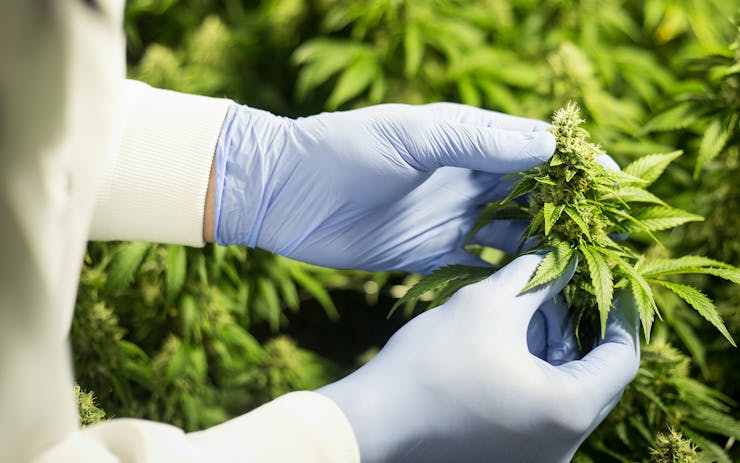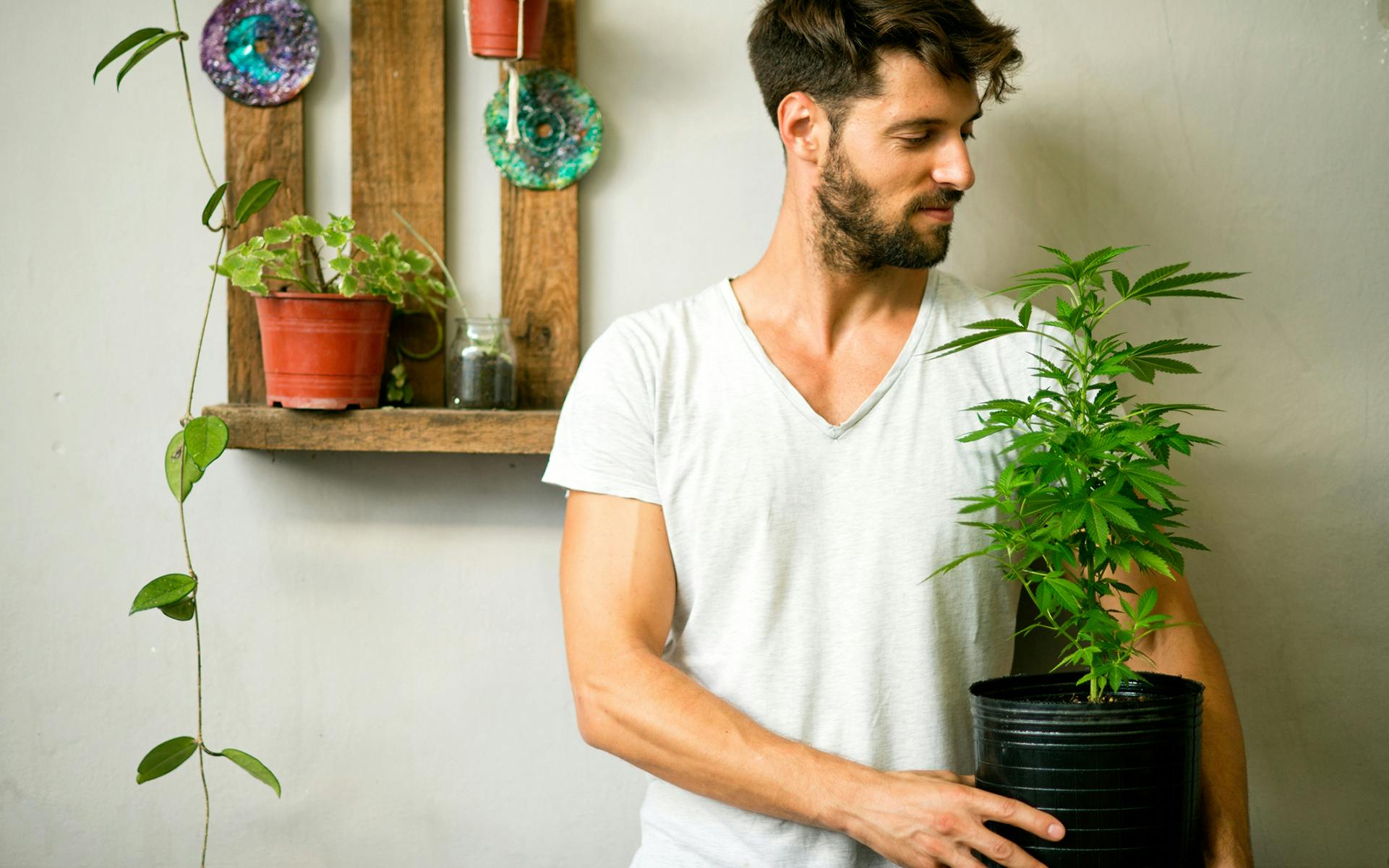Organigram is one of Canada’s leading licensed cannabis producers, providing patients with high-quality medical cannabis products since 2014.
What does a modern, state-of-the-art, indoor cannabis production facility look like from the inside? We asked Matt Rogers, head of production at the Canadian licensed producer Organigram. He shared how a constant stream of information is changing the way his team grows and the spaces they work in.
Leafly: First off, Matt, how did you get into the cannabis business?
Matt Rogers: I started in client care, working one-on-one with patients. It was a great place to start in this industry, because it gave me the opportunity to really understand our patients. I got a great sense of what they wanted and needed, challenges they may have been experiencing, and successes they were seeing.
I’ve taken that experience to the operations side of things, so every time we consider a change to our process—whether it’s a growing decision or a production technique or a way to do something faster—those customer experiences are always at the forefront of my mind. That perspective has helped me to understand how we can make our flowers, blends, and oils exactly the way they want them.

Organigram segments its flower to produce multiple product lines suitable for patients of all kinds.
What’s an example of something like that—that might make the production end a little harder, but benefits the customer?
Well, we recently launched the Edison Project, which is our premium-quality flower—the cream of the crop of our indoor-grown product. Edison flowers are clipped from very large colas that grow closer to the light than any other part of the plant. The terpenes are just oozing out of them and they’ve got a thick trichome coverage.
To retain those elements, we hand-manicure every single Edison flower. From a production standpoint, it’s a lot faster and more efficient to machine-trim, but you can only get that perfect trim, one that highlights this frosty flower, from hand-trimming. That motivated us to find ways to make hand-trimming more efficient and deliver a second-to-none premium product.
Of course, Edison may not be ideal for every patient. At Organigram, we’ve come to understand that our patients are as unique as our plants—their needs and perceptions of value are all different. That’s made us very careful and deliberate about how we divide up plants after harvest.
While top flower goes into the Edison line, other parts of the flower are going into other products that appeal to different consumers. Our smaller flowers are devoted to our Minis line, which are more budget-friendly, but still cannabinoid and terpene-rich.
Our pre-milled blends offer patients convenience of a ready-to-go product, and our oils offer patients who can’t or prefer not to combust or vaporize a long-acting, edible alternative. We’ve designed our product offerings to meet as many patients as we can exactly where they need to be.

Flower destined for Organigram’s Edison Project line is trimmed by hand.
So that’s the end product—walk us through a grow room at Organigram.
The first thing you notice before you even step in is the light. When you open the door to a grow room, the light just radiates through the whole hallway. And almost immediately after that, the aroma hits you. Each of our grow rooms can yield between 100 and 200 kilograms of dried flower, so the scent is incredibly powerful.
Once the eyes adjust, the plants come into focus. The part that tends to strike people when they’re coming through for the first time, though, is our vertical growing system. They’re really taken aback by the sights and the smells—and then they look up and see there are three tiers of these plants, as high as 25 feet above the floor. That’s when you really see jaws drop.

A three-tiered system lets Organigram make the most of indoor growing space.
How did your team develop the techniques you’re using in the grow room, and how are they evolving?
We’re in a state of rapid expansion right now, and that gives us opportunities not just to expand and scale, but to constantly think about what we’re doing and work to improve it.
Today, we have three versions of our tiered growing model active at Organigram. What I’d call Grow Room 3.0 was just implemented this year. It has some amazing benefits on the engineering and design end, but the thing I’m most proud of is the ergonomic improvements we made to the space.
Working on three separate levels presents some challenges for our grow team. The first versions of the grow rooms were mathematically designed to give us the most growing space and output. This time around, our updates were focused on making access to all three levels of the grow rooms easier, safer, and more comfortable. Working in a grow room is challenging however you slice it, and looking to the long-term, making our employees’ lives easier was a priority for Organigram.
“You have to let a plant tell you what it needs, and the data we gather helps us do that.”
Let’s dive into those difficulties a little more. What are the challenges of indoor growing, and what are the opportunities it presents?
Well, expansions like the one we’re in the middle of are more time-consuming and costly, since we can’t just buy acres of land and start planting. Three-tiered growing, for instance, makes things more complicated and costly to get up and running than, say, a greenhouse, and it takes more time and training to get staff up to speed.
It’s really not a matter of pro versus con, though; it’s a matter of what investments you choose to make. Because we’ve invested heavily in mechanical systems, we have very, very precise control over light and humidity and CO2 levels. Paired with investments in staff that can make the most of those grow rooms, we see yields out of those spaces—and quality product from those spaces—that would never be possible otherwise.

Indoor growing lets Organigram’s team create conditions where cannabis can thrive year-round.
For your money, what’s the coolest thing about indoor growing?
For me, it’s that I can control whether it’s going to be spring, summer, or fall, and have different grow rooms across our facility set to different points in the growing cycle. Whether it’s January or April or October, we can bring our customers the flower they expect, that works best for them, whenever they need it. I think that’s a tremendous value for our patients.
Given that you do have this tremendous level of control over your growing environment, what are some things your team has learned about cannabis through experimentation?
All our grow rooms are helping us learn all the time. In the span of one year, we yield five crops out of each of our grow rooms. We also have all the data about the environments those crops were produced in. And we have testing data about the terpene profile and cannabinoid content of each harvest. With 20 grow rooms going, we can gather as much information about these plants as you would get in a century of summers.
How do you keep track of all that information?
We developed a piece of software in-house called Organigrow that tracks everything we do—climate, feeding, pH of the water, labor hours—everything. We’re monitoring more than 20 different factors impacting every crop, every hour of every day. With all this data at our fingertips, we can tweak really, really incremental elements within our processes and learn how they impact the product. That’s important because there’s never going to be one factor that solves all your problems. It’s always going to be a give and take.
“With 20 grow rooms going, we can gather as much information about these plants as you would get in a century of summers.”
And of course, all those variables will have different impacts depending on the strain you’re working with, right?
Yeah, definitely. When it comes to nutrients, for example, you can think of strains like people. We all eat basically the same things, but we also have our own favorite foods. We have things that we like to eat, and that we’re not partial to; some of us eat a lot, others prefer smaller meals.
You have to let a plant tell you what it needs, and data helps us do that. It also helps make processes repeatable and scalable, so that once we find the sweet spot for a plant, we’re not hitting that most of the time; we’re hitting it all of the time.
What’s a new practice you’ve put into place that’s been driven by all this data?
Since we’re in expansion mode, automation isn’t an option—it’s a necessity. But because we’re working with delicate plants that don’t always react favorably to being handled by machines, we’ve got to be very selective about where we automate. The data we gather has been invaluable in guiding those decisions and informing our practices.
One good example is transplanting. We’re moving to a model where we will be transplanting thousands of plants every day. In the past, we’ve done that by hand, but there are some issues with that, from making sure every plant is perfectly centered in its new container to ensuring the soil is getting compacted with the same amount of pressure.
That might sound like a small thing, but it can make a big difference in how the plant absorbs water. If we have a grow room where the plants are all in soil that’s been compacted differently, they’re going to need to be watered differently. If they’re not, those plants aren’t going to look the same or grow at the same rate. And that’s not a small thing.
To address this, we purchased an automated potting machine, which is by no means groundbreaking technology. It’s basically a conveyer belt that fills pots with soil, and then uses a drill press to put a hole in the exact center of those pots. However, we supplemented this setup with a robotic arm that comes across the plant and compacts the soil around it in a uniform way. It has really let us improve the quality and consistency of the product without impacting the plants in any way.

Organigram is using data to perfect practices in its drying rooms.
Looking into the future something, what’s something you’re excited about?
I can’t wait to apply some new innovation to our curing and drying processes, because I think they’re factors in cannabis growing that are often overlooked and undervalued. You can spend 20 weeks growing the best cannabis crop in the world, and you can ruin it in five days of drying; that’s a mistake we’re not willing to make.
In one of our new drying rooms, I’ve played a lot with the airflow design, the temperature, the speed of the wind, and other variables, and we’ve seen amazing results when it comes to terpene content. Terpenes are very volatile chemicals, and they’re extremely important to not only the smell and flavor of a flower, but its effects, so it’s really important to preserve those chemicals for our patients.
By using data to fine-tune our drying and curing, we’re making sure we provide patients with the best version of the best flower we can grow.







